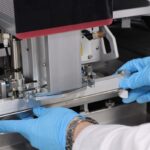ASIA ELECTRONICS INDUSTRYYOUR WINDOW TO SMART MANUFACTURING
ASMPT Offers New Hybrid Bonding for Data Highways
The high-precision AMICRA NANO die and flip-chip bonder from ASMPT has been specially developed for the production of co-packaged optics. Here, optical and electronic components are integrated in a common housing. With its exceptional process stability and a placement accuracy of ±0.2μm @ 3σ, this innovative bonding system is ideally equipped for the communication technology of the future.
Mainly, co-packaged optics manufacturing is a key process in the production of compact, miniaturized components for today’s high-performance data centers and networks that require energy-efficient and high-performance data transmission with minimal latency. To shorten the electrical signal paths, chips, and optical interfaces are tightly integrated in a very small space.

“The complexity of semiconductors is constantly increasing and poses enormous challenges, especially with regard to bonding technology,” explains Dr. Johann Weinhändler, Managing Director of ASMPT AMICRA and responsible for ASMPT’s Semiconductor Solutions Division in Europe. “The chips have more and more inputs and outputs, but they must not get any larger. This means that ever-finer structures have to be processed with high precision. This is exactly why we have developed the AMICRA NANO.”
Stable Connections with No Solder or Glue
The NANO die and flip-chip bonder overcomes these challenges. Primarily, it employs an innovative hybrid bonding technology that does not require any solder paste or glue. Instead, it creates stable mechanical and electrical connections with atomic diffusion.
Precision is the Prerequisite for Further Miniaturization
While hybrid bonding enables a high degree of miniaturization, it requires exceptional placement accuracy – in part, because the components no longer center themselves during the heat treatment. Particularly, the AMICRA NANO places dies from wafers or waffle packs with an accuracy of ±0.2µm and bonding forces ranging from 0.1 to 20N. Thus, it achieves a throughput of 200 to 400cph. With specifications like these, the machine is aimed at the high-mix/low-volume market; for example for chip sets, small lots, prototypes, or feasibility studies for new processes.
Moreover, the AMICRA NANO achieves high precision with four high-resolution camera systems that monitor the process from die pickup to final alignment and inspection. Thanks to the machine’s unique design, it is possible to map both the element being placed and the substrate through the bond head at any time. The machine even has an infrared illumination system that penetrates the dies.
Highly Flexible Technology with an Ultra-Clean Process Environment
Also, the machine is exceptional in terms of its flexibility because it can handle direct and indirect hybrid bonding as well as various soldering and gluing processes. Specifically, the AMICRA NANO offers three different heating options, including laser soldering and UV curing. Since many processes are highly sensitive to contaminants, the machine is equipped with a HEPA filtering and ionization system that ensures a high-purity operating environment.
Fast Computers Need Fast Communication
Hybrid bonding will soon be crucial wherever maximum performance is required in the smallest of spaces. This is true for high-performance and quantum computers, AI systems, IoT devices, or autonomous vehicles. “In particular, converting electrical into optical signals and vice versa is becoming increasingly important, for which light-emitting and light-sensitive components must be placed with exceptional precision,” Dr. Weinhändler sums up. “Having this fast fiber-optic communication technology at your disposal is essential if you want to exploit the potential of future data centers to the fullest.”
-20 November 2024-




